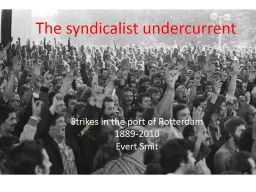

undercurrent Strikes in the port of Rotterdam 18892010 Evert Smit Research question Rotterdam port notoriously strike prone frequent occurrence of wildcat strikes Notable exception in industrial relations system in the Netherlands ID: 306258
Download Presentation The PPT/PDF document "The syndicalist" is the property of its rightful owner. Permission is granted to download and print the materials on this web site for personal, non-commercial use only, and to display it on your personal computer provided you do not modify the materials and that you retain all copyright notices contained in the materials. By downloading content from our website, you accept the terms of this agreement.
Slide1
The syndicalist
undercurrent
Strikes in the port of Rotterdam
1889-2010
Evert SmitSlide2
Research question
Rotterdam port notoriously strike prone, frequent occurrence of wildcat strikesNotable exception in industrial relations’ system in the Netherlands (“poldermodel”)
Conflict prone ports is
an international phenomenon, with long history
How did this strike pattern emerge and develop, why was it so ineradicable?
Looking for
underlying causes
, rather then immediate and conditioning causes
Definition of ‘strike’: a temporary collective refusal to work by the workers, which is not condoned by their
employer
Wildcat or
spontaneous
strike is not organized by the unionSlide3
Theory
Tradition of ‘industrial relations’Katz & Kochan (1992), strategic choice model: focusses on collective bargaining level and formal institutions‘Employment relations’
Concept of ‘employment relationship’ (Kaufman, 2004) focusses on informal relations at shop floor level
Economic
exchange
Authority
relationship
Implicit (psychological) contract
Kerr & Siegel (1954), geographical isolation
Miller (1968), universal dockworkers’ subcultureSlide4
Method
Historical-sociological study (1889-2010): analysis in context of historical developments and evolution of industrial relations’ system Development of database of all (570) strikesWide range of sources (interviews, archives, secondary documents, et cetera)Slide5
Findings: the factsSlide6
Average
number
of strikes per
annum
1889-1914
1915-1940
1945-1969
1970-1989
1990-2009
3,8
3,8
5,1
7,2
5,5
79%
wildcat
91%
wildcat
99%
wildcat
81%
wildcat
62%
wildcatSlide7
Average
nummer of
striker
days
per
annum
jaar
per 1000
workers
1889-1914
1915-1940
1945-1969
1970-1989
1990-2009
2.007
3.464
2.219
2.672
258Slide8
Interindustry
propensity to strike
Yearly average number of striker days per 1.000 workers
1889-1914
1915-1940
1945-1969
1970-1989
1990-2009
Storage and transshipment
1.243
2.232
973
704
40
Mining
613
966
95
11
0
Diamondindustry
1.869
52
Metalindustry
44
447
50
113
16
Building trades
160
450
149
35
153
All branches together
55
213
36
36
20Slide9
Findings: underlying
causesCasual labourAutonomy in the labour processDockworkers’ cultureSlide10
Casual labour
E
ntirely ‘free’ labour market ( - 1918Slide11
Casual
labour
Hiring
halls (1918 - 1955)
Labour pool (1955 – 2009)Slide12
Casual labour
Irregular income, social insecurityFree spirited mentality
Daily negotiations and conflicts
The logic of direct action
Support for syndicalist unions
After
fixed
contract in labour pool (1955-2009), pool workers
kept on regarding themselves
as
‘casual workers’
Strike pattern as the unintended consequence of transaction
cost
economics (poor management control)
E
conomic exchange and authority in employment relationship Slide13
Autonomy in the labour
process
Slide14
Autonomy in the labour process
Conventional general cargo (breakbulk) transhipment not suited for mechanisation and Taylorist controlRelative autonomy in the labour process: basis of power for dockworkers
Non-contractual bargaining at the shop floor
Small conflicts and direct action with a new look
The dominant explanation in the heydays of general cargo
Containerisation completely changed this picture
Braverman
(1985), technology, labour process and shop floor politicsSlide15
Dockworkers’ cultureSlide16
Dockworkers’ culture
Rough and casual jobs with low management control fosters independent spirits, and draws tough, combative and virile workers Teamwork fosters social control and strong solidarity (‘one in trouble, all in trouble’)‘Casual frame of mind’, anti-intellectualism,
anti
- or
a
political views
Geen
woorden
maar
daden
, hand in hand de
kameraden
(
Feyenoord
)
Sterker
door
strijd
(City shield of Rotterdam)
Proud to be a
docker
‘Culture lag’ (conditions changed significantly, legacies of the past remain)
Dockworkers’ culture as a ‘repertoire of collective action’ mythologized by the union and source of continuity of strike frequency in container eraSlide17
Some contextual factors
Major peaks in strike volume appear in times of societal upheaval Importance of the port in the national economy attracts media and political attention to industrial conflict and fuels self confidence of dockworkersGlobalisation of logistic chains increases structural power of dockworkers and unions
Strategic choices of parties in industrial relations can have severe influence on strike levelsSlide18
Conclusion
The end of the syndicalist undercurrent?Slide19